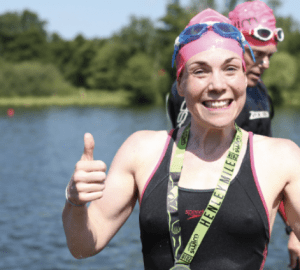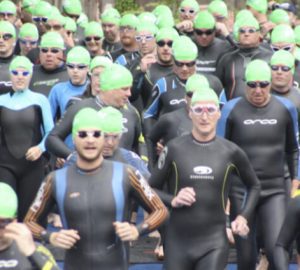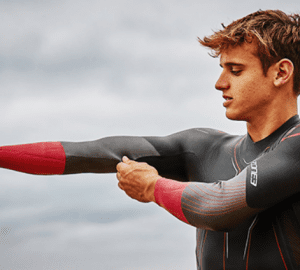Stroke Counting: Why and How
The two numbers that swimmers habitually track are how many metres or yards they tally in a workout – or some calendar period – and the time it takes to complete some portion of that tally. “I swam 3000 metres today and did 1:39 on my fastest 100.”
It’s far less common to monitor stroke count. Yet, for several reasons, stroke count is arguably the most important measure:
1. Regular Feedback
Feedback – a way to connect efforts to outcomes – is the key to improvement and personal best performance. Feedback is most effective when it comes moment-by-moment. You learn your time for a repeat only after you finish swimming. In contrast, you can monitor stroke count every lap, alerting you to loss of efficiency or variation in Stroke Length.
2. Numbers that Matter
Stroke Length – the distance you travel on each stroke – has been shown repeatedly to correlate more closely with performance than any other aspect of swimming. In contrast, there is a relatively poor connection between the number of metres you tally in training and how well you swim. Counting strokes is the most basic and accessible way to monitor Stroke Length.
3. Simple and Convenient
There is no simpler way (no batteries required!) to begin collecting feedback on how you’re swimming. Counting strokes is one of the two fundamental ways (using Stroke Thoughts or Focal Points, on which I have written before in H2Open, is the other) to become your own best coach.
4. Practice Mindfulness
Stroke counting became my first exercise in mindful swimming, and the first step in transforming a workout into a practice. As with meditation practice, your mind will drift away from the task at first, and you’ll lose count. Patiently restart on the next lap.
How do I count strokes?
Count each hand entry on each pool length. You begin each lap by initiating your first stroke while still in streamlined pushoff. You complete that stroke as your hand enters the water after surfacing. Count every hand entry through the final one going into your turn.
Can I use a watch to count for me?
You can – and it’s certainly better to get data this way than not at all. However, I prefer counting mentally because:
• It provides real-time feedback.
As with repeat time, a watch doesn’t provide that feedback until after you stop swimming.
• It’s good for your brain.
Billions of neurons go to sleep when you ‘follow the black line’ or zone out while swimming. Stroke counting keeps them alert.
What’s a good stroke count?
When stroking efficiently, you should travel between 55% and 65% of height on each stroke. We’ve converted that into stroke counts for 25 metres on the height-indexed ‘Green Zone’ chart below. (To estimate efficient counts for the other strokes, add two strokes to your freestyle range for backstroke. For butterfly and breaststroke, you should take about half as many strokes as in backstroke.)
Stroke Count Exercises
Strive to perform each exercise within your Green Zone stroke count range.

1. Compare Focal Points
In the article ‘Mindful Practice Makes Perfect’ (Aug/Sept 2016), I described three types of Focal Points: Balance, Stream-line, and Propulsion. Use stroke count to compare the effect on stroke efficiency as you vary your technique focus. Swim four rounds of 4 x 25m. On the first round, swim normally. Then swim a round each with the three stroke thoughts – one from each category. Compare stroke counts in each round.
a.
‘Hang’ your Head: Completely release your head’s weight until you feel that head and spine are aligned. Look down, not forward.
b.
Swim Taller: On each stroke, use your reaching arm to extend your bodyline (ignore the hand pushing back). Stretch forward until you feel your underarm open.
c.
Match Speeds: Try to match the speed of your hand stroking back to the speed of your body moving forward. And eliminate bubbles while you’re at it.
2. Practise ‘Gears’
Gears on your bike and car allow you to use less energy while traveling faster. Changing stroke counts is the simplest way to introduce gears into your swimming. To develop command of gears in your own swimming, swim 4 rounds of (3 x 25m) as follows. Choose three consecutive counts from your Green Zone and swim each round of 3 x 25m as follows: n, n+1, n+2. (e.g. 18, 19, 20.) In successive rounds your goal is to improve calibration; i.e. your ability to strike the wall, in rhythm, in the count you chose – and to adjust easily on the next length. As calibration – and ‘confident stroking’ – improve, you should feel an effortless increase in pace as you add a stroke. For extra credit, repeat the set in reverse, i.e. 3 x 25m at 20-19-18 strokes.
3. Hold Your Count
Consistent Stroke Length is a recipe for steady pacing in distance swimming, even at distances as short as 200 metres. Consistency in stroke count is a simple way to develop this skill. Try this set (4 x 25m + 3 x 50m + 2 x 75m + 1 x 100m). Strive to hold a consistent count on the 25s. On the 50s, swim the first lap in the same count as your 25s and allow one more stroke on the second lap. On the 75s, hold your 25m count on the first lap, add one stroke on the second lap, and an additional stroke on the third lap. On the 100, aim for +1 stroke on the second and third laps and +2 on the fourth length. Use the Focal Point that produced the most efficient count.
4. Pacing Test #1 Constant Count 100s
Swim 3 x 100m at a constant stroke count, following the pattern from the final 100m in the set above (n, n+1, n+1, n+2). If you don’t succeed on your first go, take a breather and try again. In fact, keep trying (over several practices if needed) until you succeed. This is a simple way to (i) maintain constant efficiency over a series of repeats; and (ii) swim an even pace on each repeat. When you succeed, progress to the next two tests.
5. Pacing Test #2 Constant Count and Pace
Swim 3 x 100m at constant stroke count and time. If both your stroke count, and your time remain constant, this means you are also controlling Stroke Rate, the third variable in the equation Velocity = Stroke Length x Stroke Rate. Though you won’t be conscious of Stroke Rate, you’ll keep it constant by feel just by striving to keep stroke count and time constant. The essential skill of fast swimming (particularly at distances of 400 metres or more) is the ability to control – and strategically adjust – those metrics to minimise effort while maintaining or increasing your pace.
6. Pacing Test #3 Constant Count, Increase Pace
Swim 3 x 100m at constant stroke count, while descending or improving time. e.g. Swim all three 100s in a total of 76 strokes, with successive times of 1:41, 1:40, 1:39. This is an especially challenging test, one that very few swimmers – even highly accomplished club swimmers – will master on their first try. However, this skill is learnable with practice.








